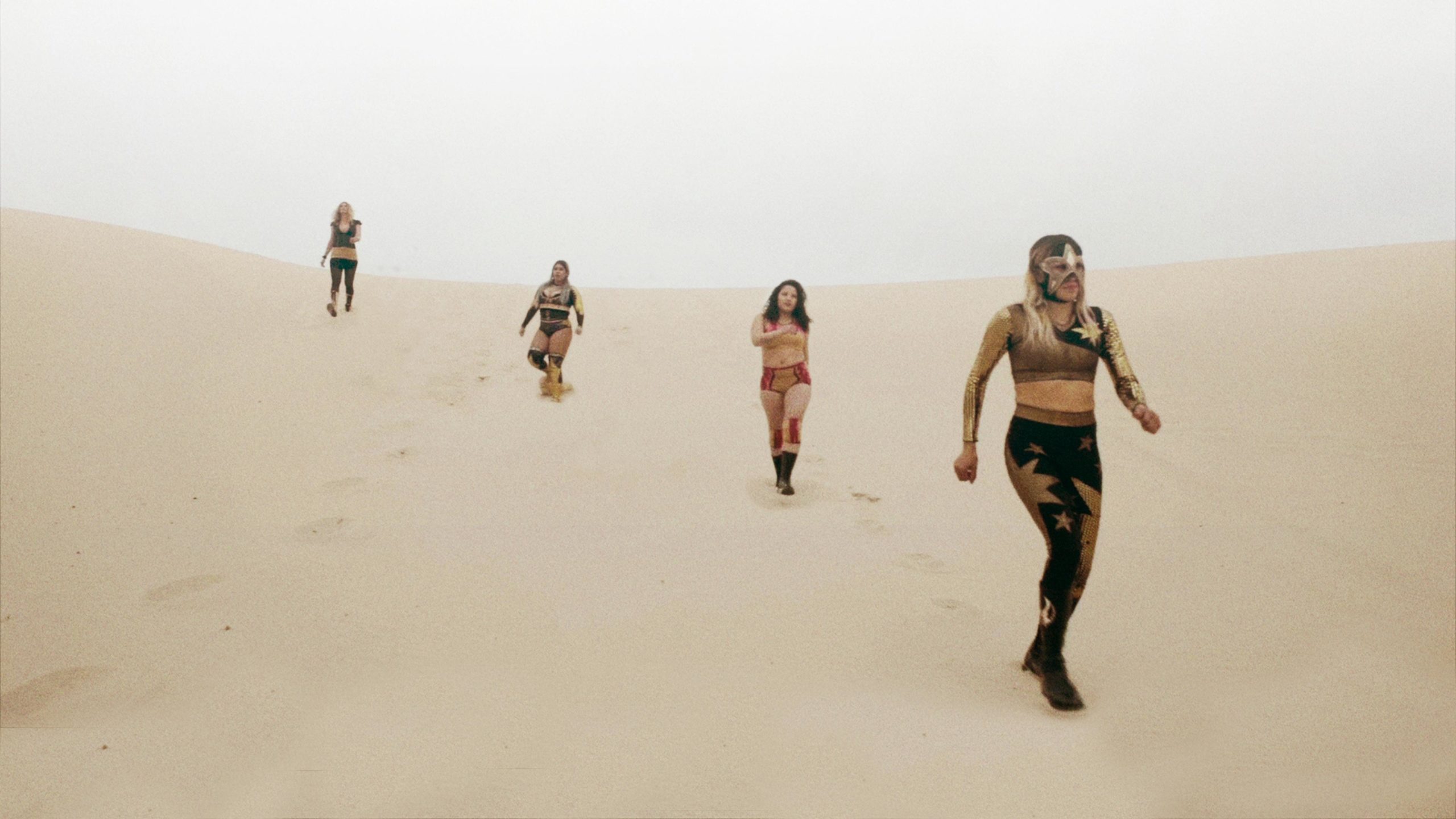
Commanding the ring with resilience and grit, Luchadoras is a documentary that finds and emphasizes power in community.
Making its world premiere at SXSW, Luchadoras follows a group of luchadoras living in Ciudad Juárez, Mexico. A city notorious for its high femicide rates, the documentary gives a glimpse into the ways women in Juárez reclaim their strength.
Earlier this week, we had the chance to chat with co-director Paola Calvo on the documentary and get a little more insight into the creation of Luchadoras!
*This interview has been edited for length & clarity.

Q: I wanted to know a little bit more about how you got into the story, the subject matter, and what made you decide to make this documentary?
PC: Well, you know, we hear here in Europe, what you hear about Juárez, is that it’s a place known because of this horrible violence against woman. And we — Patrick and me, the co director, we were very focused on the place. We’re wondering how. How can it be? How can people live in such a place like that? How is it like that. So we have some friends there, in Juárez. Through them, we discovered that actually, Ciudad Juárez is also a very important place for Lucha Libre. We thought that the contrast is very big, a place where a woman are treated as victims and where a woman suffer a lot of violence at the same time. In the same place, there are a lot of woman who jump in the ring and show themselves super strong. So we thought that this was super powerful. We decided to go there and meet the people. From the very first moment where we met our protagonists and it was clear, okay, there is so much power, there is so much energy. There is so much detail about this place and these women that it was clear that we wanted to bring it to an to an audience and let the world know about that.
Q: Your subjects themselves, the people, how did you find them? And was it easy gaining access to them?
PC: We found them, just going to the fights and then watching them and observing. Anyway, we did a lot of research on the internet before that, of course. But as we have these friends who know all the people there before, it was a bit easier to get in touch with them. And to build up the first trust, let’s say because of course, you can’t trust the first people that comes to you and say, I want to make a film for you. So thanks to our friends, we managed to break this first step, let’s say, or to make this first step. Then it was clearly like in the moment, where we explained what we wanted to do. We wanted to spend time with them in the real life and their daily life. All of them were saying “But Paola, we are like super boring. I don’t know what you want to be with us.” And I was like, no, no, no, this is exactly (what) we need! Your daily life, just like doing the the breakfast and then going to work and unless things are super important, because you learn a lot of things through that in documentaries. So yeah, it was a slowly. With some, it took more time to build up this trust. But I think in the moment and with other protagonists, it was much easier. They were there from the very first moment, but it’s normal. So the important thing is that we managed to understand each other and we managed to mainly have a lot of fun. Like it was a lot of fun spending time with the protagonists. We learned a lot from the experience in Juárez and we learnt a lot from our protagonists. So it was a really, it was a really interesting and nice nice moments.
Q: I’m interested in in the shooting process itself. What was the shooting process in Juárez? With the subjects themselves, were they apprehensive, or kind of hesitant to show you certain parts of their lives that we ended up seeing in film? Or were they pretty open?
PC: Shooting in Juárez, I have to say that the danger in Juárez is real. The things that happened in Juárez, they are real, they’re not just stories people tell, like, the violence is very big. You don’t know what’s going to happen and when it’s going to happen. I don’t like to talk about the shooting in Juárez, I think the life in Juárez is surrounded by this dangerous situation. So if we’re shooting or not, that’s not important. The thing is that people live there. They are constantly being forced to deal with violence, and they’re constantly being forced to deal with danger. So one of the biggest consequences of that is that you develop fear. In the moment where you are, when you fear something, when you’re very afraid of something, then the way you react and the way you interact with all the people around you, it’s going to be totally different. So I think the most difficult part of being in Juárez is to learn to deal with that. Learn to deal with your fears and learn to know: Is it paranoia? Or is it a real fear what I’m feeling now? Should I trust my belly and not go there? The most challenging thing is when you’re living in such a place, people develop their own strategies, how to deal with that. They changed everything, like fear and danger, change everything, how people react to each other. But it was nice that we realized also, even though the fear and the danger is there, there are big and very strong communities. That’s the way people deal with the situation. Because here, for example, in Germany, or in Berlin, people are very lonely souls walking in the street and doing their own and they don’t care if you’re here, there, if you’re wearing black or white, whatever, no problem, so it’s very independent. But then I realized in Juárez, it’s super important to be part of a group. That’s the way you feel safe. That’s the way you can have a structure ,where you can have a life and be happy. This was super, super important for us to understand when we were there. I mean, our protagonist, they were very open. They would usually let us film almost everything. There was one thing. When you see the film, there is this one person who was wearing the mask. So this was the only thing that we thought about and that we said, okay, because we wanted to portray her as a luchadora. It was important to keep her identity hidden, because that’s her role in the in the ring. So it was important not to show her without the mask. Apart from that, it was very, it was very open. Very nice!
LUCHADORAS – Official Trailer from TUMULT on Vimeo.
Q: Going off the previous of the question of what was one of the most important themes that you wanted to get across to the audience itself?
PC: That’s a very big question. I would like the audience to first of all, to feel empowered. And to think that if there is any kind of injustice somebody is experiencing, they should get the energy and the power to stand up and fight for justice. Because it’s very important to defend your position, it’s important to defend your feelings. This is the first thing. I would say there is this feminist speech, which I think it’s super important to talk about, and which I think it’s super important to communicate. I have the feeling, not only feeling, I know, that feminism is a word that has a lot of negative connotations. I know that for many people to hear, oh, she’s a feminist, it’s like, almost if she is killing man or something. There are a lot of really false ideas connected to these topics. I would like people to take time and analyze these concepts and begin dialogue and try to understand feminism only wants equality and wants a woman to be empowered in their own bodies. I think this is super important. We cannot live in a society where love and connection is there if we don’t respect this term. Machismo is something that it’s there. It’s there in some places more clear than in other places, but it’s there. It’s the base of the system we’re living in and we have to be aware of that. We have to change that. Because if not, I mean, we’re killing the world. We’re killing the women. Soon, there’s not gonna be anything there left. So we really have to take care and pay attention to that.
Q: Once you have all your footage, how do you weave every story together? And was there anything left on the editing floor that you loved, but didn’t actually make it into the final cut?
PC: Of course, there’s so many. There’s so many nice moments. fThe most important thing, we took the decision to take out one of the protagonists. At the beginning, there were supposed to be four. But then after a lot of work, and a lot of you know, trying to put all the puzzles together, we realized that the fourth one was not really matching the other ones. So we had to take her out. One of the most painful decisions we took in the whole process was to take out one of the people who was (there) in the beginning part of the of the film. And yeah, of course, there’s a lot. I mean, we were shooting for five, six months in Juárez. So you can imagine we had a lot of material. It was very difficult, like taking away all your babies and your darlings. Kill your darlings, they say. We really killed a lot of them. And it was painful. But we are happy at the end with the film.
Q: What’s next? Do you still want to stay within the same topic? Are you still interested in documentaries?
PC: I have a lot of ideas going through my head. I mean I love documentary filmmaking. I think it’s a way of personal growth. I think it’s super, super, important to go and visit real people and tell people stories. Because sometimes reality is stranger than fiction. It’s more powerful than fiction, even though some people might not think that. I have a couple of ideas, or we have — Patrick and I. We’re working together on a couple of ideas that are still developing. I would love to do a horror movie. If I leave documentary filmmaking, then I will go to the horror scene. I already have some ideas what to tell. But this will be in the very, very, very, very future. Not now, this is something that takes takes time! I’m working on documentaries.